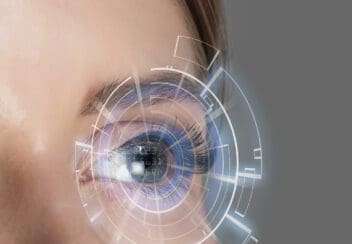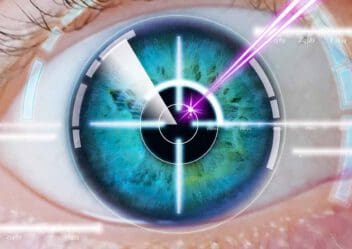Guide to Bionic Eyes: Implants, Lenses & the Status in 2022
Home / Vision Education Center /
Last Updated:
Bionic eyes, still in their infancy, offer hope for restoring sight through various types of technology, including the Argus II Retinal Prosthesis System, tested on hundreds of individuals. Alongside this development, bionic lenses present an innovative solution for enhancing vision for those already using corrective eyewear, although not typically intended for vision loss. The field continues to evolve, showing promise for numerous causes of vision impairment in the future.
Table of Contents
Bionic eyes are implanted to replace natural eyes. They use various types of technology, depending on the specific eye or prototype.
In 2012, a rudimentary version of a bionic eye was first implanted. This is a new technology, but so far, the promise that it shows could result in the restoration of sight for people who would otherwise be dealing with permanent vision loss.
As scientists continue to explore bionic eyes and the technology evolves in 2022 and beyond, various lenses and other options are becoming available. Such research could result in bionic eye options for numerous causes of vision loss in the future.
Since this technology is new, there are many directions that bionic eyes could take. For now, learning about what is available and some potential enhancements will give you a clearer picture about how bionic eyes may help people in the future.
What Are Bionic Eyes?

Bionic eyes may help to restore vision for those with low vision and blindness. In the United States, there is one bionic eye in development. This specific one is only for the blindness that specific eye diseases cause.
Unlike a prosthetic eye, bionic ones are functional instead of cosmetic. When someone develops blindness, they cannot see correctly. This can occur due to several factors, such as diseases or damage to the lens or cornea, a lost signal along the brain’s visual pathway, or the retina being unable to perceive light.
The various bionic eyes in development throughout the world target different visual pathway areas. In the U.S., the bionic eye in development is the Argus II Retinal Prosthesis System. It is being tested to restore sight for age-related macular degeneration.
This bionic eye has been used to restore at least some visual perception in people with severe retinitis pigmentosa. So far, the testing has involved hundreds of people.
Implants & How They Work
These implants take pictures with a video camera and transform the images into a representation with high contrast. A portion is taken for additional processing. The Argus system consists of a pair of eyeglasses, a small camera, and tiny electrodes.
The camera is on the eyeglasses. The electrodes are implanted into the retina at the back of the eye. When a person looks at something, it is converted into signals. These are wirelessly transmitted to the implant in the retina.
You deserve clear vision. We can help.
With 135+ locations and over 2.5 million procedures performed, our board-certified eye surgeons deliver results you can trust.
Your journey to better vision starts here.
The retinal cells are stimulated by the electrodes. This results in incoming information being sent to the optic nerve. From here, the brain processes this information.
The Argus system lets people tell the difference between shapes, movement, and light. However, it does not allow people to see in the same way that healthy eyes function. Researchers believe that this is due to only 60 electrodes being part of the device.
Some people who received the implant were able to cross streets without assistance and read books with large print. However, they could not accurately perceive colors.
But in 2021, advancements in computer modeling enabled improvements in the Argus II Retinal Prosthesis System. Essentially, researchers at USC developed signals that could enable better clarity and color vision for those using the Argus II. This could open up a whole new world for those who need eye implants, making them more functional than ever before.
Still, approximately 1 million electrodes would be necessary for natural sight. The developer of this implant is working on one that will have 240 electrodes and peripheral electrodes to improve the size of a person’s visual field.
The History of Bionic Eyes

A precursor to bionic eyes was developed in 1755 by Charles Leroy, a French physician. Using a Leyden jar, he discharged static electricity from it into the body of a blind individual. He accomplished this with two wires. The person said he experienced a flicker of visual perception as a result.
Since this time, scientists and doctors have been working on more modern ways to allow people to see. Various devices have been explored, including those that have allowed people to:
- Recognize and locate objects.
- Perform certain reading tasks.
- Detect elements of an unfamiliar environment.
So far, this technology is still in its infancy. There are some bionic eyes that have been tested in humans that are promising. But to provide highly functional sight restoration, major improvements are still needed.
Additional research is aimed at helping people regain vision without the use of implants as well. In 2022, gene therapy shows promise. A blind man experienced some modest vision improvements after receiving a gene for a light-sensing algae protein. This may develop into an alternative treatment that doesn’t require surgery, like bionic implants do.
Bionic Lenses
Bionic lenses are another option, but they are not usually for people with vision loss. Instead, they offer improvements in vision for those who already wear contact lenses or eyeglasses. Several companies are working on developing bionic lenses, all of which use slightly different technology and approaches.
Bionic lenses replace the natural lenses of the eyes. Essentially, a surgeon would remove a person’s natural lens and implant a bionic lens in its place. The purpose is to restore vision at all distances, so the person does not experience any issues with their vision quality.
Some bionic lens technology aims to autoregulate once it is implanted into the eye. The surgeon would connect it to the muscles so it is able to focus at different ranges. This could also result in no risk of eye strain since these lenses would use 1/100 as much energy as a natural lens uses to respond.
You deserve clear vision. We can help.
With 135+ locations and over 2.5 million procedures performed, our board-certified eye surgeons deliver results you can trust.
Your journey to better vision starts here.
Science & Status of Bionic Eyes
Throughout the world, hundreds of people have received an Argus II Retinal Prosthesis System transplant. So far, the results show that this implant is stable and reliable for people who have advanced retinitis pigmentosa.
A recent follow-up study included 30 people who received the implant five years prior. For 24 of these people, the implant remained functional and in place. Three of the implants were explanted as a result of adverse events, and two devices failed.
In mobility testing (follow the line and follow the door), the people who received the implant moved around more successfully when they had their implant on versus when they turned it off.
Another study looked at people with dry age-related macular degeneration. There were four people in the study. Over the subfoveal geographic atrophy area, the device was shown to elicit central vision function.
In 2021, the system gained FDA approval, which will open the door to more widespread use.
Bionic eyes may help people to improve their vision when other methods are not enough. An eye doctor with knowledge of this type of medicine is needed. Since it’s a niche field, specialists are required.
Looking to the Future
The goal is to develop bionic eyes with more electrodes. It’s believed this will result in more natural vision for those with the implant.
With the Argus II specifically, the company that developed the implant is working to increase their 60-electrode model to 240 electrodes. It’s expected that this will result in significant vision gains for those with these implants.
You deserve clear vision. We can help.
With 135+ locations and over 2.5 million procedures performed, our board-certified eye surgeons deliver results you can trust.
Your journey to better vision starts here.
References
- The Gold Standard for the Bionic Eye. (July 2019). Johns Hopkins Medicine.
- Bionic Vision. (September 2016). American Academy of Ophthalmology.
- Argus II Retinal Prosthesis System Dry AMD Feasibility Study Protocol. U.S. National Library of Medicine.
- Bionic Eye. (November 2017). Circuit Digest.
- The Functional Performance of the Argus II Retinal Prosthesis. (November 2013). Expert Review of Medical Devices.
- The Bionic Eye. (October 2014). The Scientist.
- A Bionic Lens Undergoing Clinical Trials Could Soon Give You Superhuman Abilities. (August 2017). Big Think.
- Advanced Computer Model Enables Improvements to “Bionic Eye” Technology. (April 2021). SciTechDaily.
- Second Sight Medical Products, Inc. Receives FDA Approval for the Argus 2s Retinal Prosthesis System. (March 2021). Business Wire.
This content is for informational purposes only. It may have been reviewed by a licensed physician, but is not intended to serve as a substitute for professional medical advice. Always consult your healthcare provider with any health concerns. For more, read our Privacy Policy and Editorial Policy.
